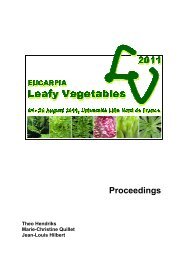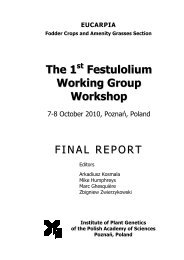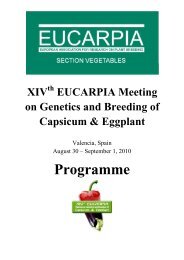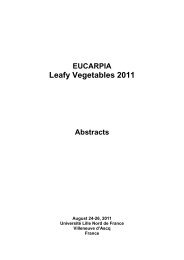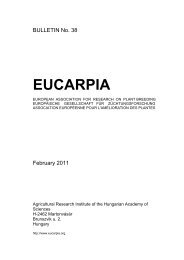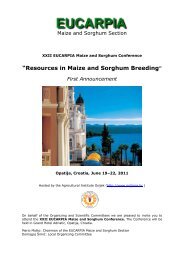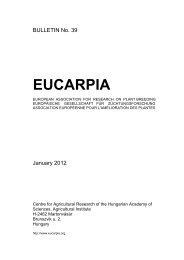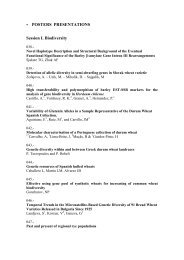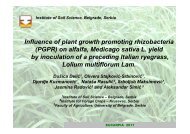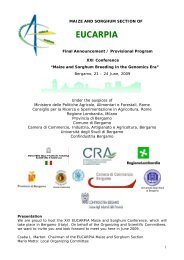Plant breeding for organic and sustainable, low-input agriculture
Plant breeding for organic and sustainable, low-input agriculture
Plant breeding for organic and sustainable, low-input agriculture
You also want an ePaper? Increase the reach of your titles
YUMPU automatically turns print PDFs into web optimized ePapers that Google loves.
The pattern of N uptake in time, N translocation <strong>and</strong> root growth as possible factors<br />
determining genotype x environment interactions in wheat (Triticum aestivum L.)<br />
Jörg Peter Baresel, Hans-Jürgen Reents<br />
Technical University of Munich, Chair of <strong>organic</strong> Farming, Freising, Germany<br />
Baking quality of wheat grown under <strong>organic</strong> management in Germany often does not match the<br />
requirements of the milling <strong>and</strong> baking industry. Like in other species <strong>and</strong> <strong>for</strong> more general<br />
criteria, it has there<strong>for</strong>e often been proposed, to breed special varieties adapted to the conditions<br />
of <strong>organic</strong> farming. There are two ways to improve baking quality: one is to improve protein<br />
quality, another possibility is an improvement of nitrogen (N) efficiency <strong>and</strong> thus, grain protein<br />
content. Subject of this contribution is N efficiency, which is here intended as the ratio of grain N<br />
uptake to N availability. Objectives of our trials were, to explain a part of the genotype x<br />
environment interactions on N efficiency, analyzing N uptake, N partitioning <strong>and</strong> N translocation<br />
processes of selected varieties in conditions of <strong>organic</strong> farming. Our focus is specifically on the<br />
temporal patterns of N dynamics.<br />
Six varieties (Altos, Batis, Bussard, Capo, Dream <strong>and</strong> Naturastar) were grown in replicated plots<br />
over three years in four locations, differing in yield potential. All trials were conducted on<br />
<strong>organic</strong> farms. Above-ground N uptake was determined at the development stages EC 32 (begin<br />
of stem elongation), 62 (begin of f<strong>low</strong>ering) <strong>and</strong> 95 (ripeness). At EC 95, grain <strong>and</strong> straw N<br />
content were determined separately. Soil samples <strong>for</strong> determination of mineral soluble N were<br />
taken in early spring <strong>and</strong> at the EC stages 32, 62 <strong>and</strong> 95 from surface to a depth of 90 cm. Total<br />
mineralization <strong>and</strong> mineralization in single sub-periods, N uptake be<strong>for</strong>e <strong>and</strong> after anthesis <strong>and</strong> N<br />
translocation from vegetative tissues to the grain were estimated basing on these data. Root<br />
growth of the same six varieties was observed nondestructively in a separate trial in cylindrical<br />
vessels of transparent polyethylene. The height of the vessels was 1.4 m, their diameter 25 cm.<br />
The estimated global amount of mineralized N ranged from 160 to 220 kg/ha in the whole cycle;<br />
approx. 70-120 kg (60%) were absorbed by the plant canopy. Mineralization during grain filling<br />
varied from 0 to 15 \% of totally mineralized N. The variability of mineralization among<br />
environments was highest after anthesis. There were significant differences in total N uptake of<br />
the varieties. Differences between varieties were <strong>low</strong> in the earlier development stages, while N<br />
uptake during the grain filling stage, despite contributing little to total uptake, were most<br />
variable, but only in environments with relatively high N availability. Thus, genetic differences<br />
of N efficiency depended mainly on uptake ability in the later stages. The pattern of root<br />
development in time varied among the varieties <strong>and</strong> was in part correlated with the temporal<br />
pattern of N uptake: consequently, the differences in N efficiency <strong>and</strong> in N uptake in time may<br />
be partly due to differences in root growth. Significant differences could also be found in the<br />
proportion of direct N uptake after anthesis <strong>and</strong> N translocation from vegetative plant tissues into<br />
the grain.<br />
Three main conclusions may be drawn from the results: (1) Organic farming may include very<br />
different environments, with different requirements on varieties, also with respect to the<br />
physiology of N uptake <strong>and</strong> utilization. (2) The pattern of N uptake in time, <strong>and</strong> N translocation<br />
processes are of importance: uptake efficiency in late development stages may be useful in<br />
environments with relatively high N availability, genotypes with a uptake efficiency in earlier<br />
development stages <strong>and</strong> a high translocation efficiency may be better adapted to environments<br />
with <strong>low</strong> N availability. (3) Root growth <strong>and</strong> the temporal pattern of root development may play<br />
a role in N uptake efficiency.<br />
24




